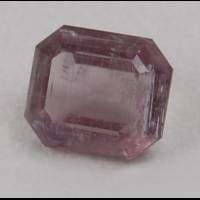Anhydrite

Simplon Railway tunnel (north section), Termen, Brig, Valais, Switzerland
3.89 carats
© Rarestone.com
When exposed to water, anhydrite transforms to gypsum by the absorption of water. This transformation is reversible, gypsum forms anhydrite by heating to ~200°C under normal atmospheric conditions.
Fine specimens are very rare. Small crystals and pieces of clean facet-grade rough are found in salt mines. Anhydrite is very rarely faceted or cut as cabochons.
Anhydrite Gemstones by Colour
This table shows the variety of hues this gemstone can be found in. Click on a photo for more information.
Anhydrite Gemstones by Size
This table shows distribution of Anhydrite gemstone sizes that are listed on this site. This can give a good indication as to the general availability of this gemstone in different sizes.
Contributed photos
Lightest:2.30 cts
Heaviest:3.89 cts
Average:3.10 cts
Total photos:2
Do you have a larger Anhydrite? Why not upload a photo?
| General Information | ||||||||||||||||||||||||
|---|---|---|---|---|---|---|---|---|---|---|---|---|---|---|---|---|---|---|---|---|---|---|---|---|
| Varieties/Types: | ||||||||||||||||||||||||
| Chemical Formula |
| |||||||||||||||||||||||
| Physical Properties of Anhydrite | ||||||||||||||||||||||||
| Mohs Hardness | 3.5, Gemmological Tables (2004) More from other references | |||||||||||||||||||||||
| Specific Gravity | 2.90 to 2.98, Gemstones of the world (2001) More from other references | |||||||||||||||||||||||
| Cleavage Quality | Perfect, Gemmological Tables (2004) More from other references | |||||||||||||||||||||||
| Fracture | Uneven, Gemstones (2009) | |||||||||||||||||||||||
| Optical Properties of Anhydrite | ||||||||||||||||||||||||
| Refractive Index | 1.570 to 1.614, Gemmological Tables (2004) More from other references | |||||||||||||||||||||||
| Optical Character | Biaxial/+, Gemmological Tables (2004) More from other references | |||||||||||||||||||||||
| Birefringence | 0.044, Gemmological Tables (2004) More from other references | |||||||||||||||||||||||
| Pleochroism | Weak, Gemstones (2009) | |||||||||||||||||||||||
| Dispersion | 0.013, Gemstones (2009) | |||||||||||||||||||||||
| Colour | ||||||||||||||||||||||||
| Colour (General) | Colourless to light pink, pale blue to violet., Gems, Sixth edition (2006) More from other references | |||||||||||||||||||||||
| Transparency | Transparent,Translucent, Gems, Sixth edition (2006) More from other references | |||||||||||||||||||||||
| Lustre | Vitreous, Gemstones (2009) | |||||||||||||||||||||||
| Fluorescence & other light emissions | ||||||||||||||||||||||||
| Fluorescence (Long-Wave UV) | Some German anhydrite may show a red fluorescence under LWUV., Gems, Sixth edition (2006) | |||||||||||||||||||||||
| Crystallography of Anhydrite | ||||||||||||||||||||||||
| Crystal System | Orthorhombic, Gemmological Tables (2004) More from other references | |||||||||||||||||||||||
| Habit | Tabular or equant crystals, Gems, Sixth edition (2006) More from other references | |||||||||||||||||||||||
| Geological Environment | ||||||||||||||||||||||||
| Where found: | Is usually formed by the dehydration of gypsum, Gems, Sixth edition (2006) | |||||||||||||||||||||||
| Further Information | ||||||||||||||||||||||||
| Mineral information: | Anhydrite information at mindat.org | |||||||||||||||||||||||
| Significant Gem Localities | ||||||||||||||||||||||||
| ||||||||||||||||||||||||

